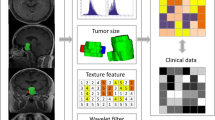Abstract
Introduction
The purpose of this study was to evaluate the potential of a high-resolution contrast-enhanced magnetic resonance angiography (CE-MRA) at 3 Tesla for the delineation of the cavernous sinus (CS) anatomy both under normal and under pathological conditions.
Methods
Fifteen patients without pathologies in the CS and ten patients with pituitary adenomas were included. The CE-MRA was performed on a 3-Tesla scanner and analyzed collaboratively by two readers. The cranial nerves (CNs) within the CS, namely CNIII, CNIV, CNV1, CNV2, and CNVI, were identified in both patient groups. In the adenoma patients it was also assessed whether and to which extend the adenoma invaded the CS and the spatial relationship between tumor and CNs was determined.
Results
In the patients with normal CS anatomy, CNIII could be identified in 100%, CNIV in 86.7%, and CNV1, CNV2, as well as CNVI in 100% of analyzed sides. Pituitary adenomas invaded the CS unilaterally (right side) in four patients, and bilaterally in six patients. In patients with adenomas, the CN could be identified and differentiated from the tumor in the following percentages: CNIII in 100%, CNIV in 70%, both CNV1 and CNV2 in 90%, and CNVI in 100%. In all these cases, the tumor–nerve spatial relationship could be visualized.
Conclusions
3-Tesla CE-MRA allows detailed imaging of the complex anatomy of the CS and its structures. In adenoma patients, it clearly visualizes the spatial relationship between tumor and CNs, and thus might be helpful to optimize presurgical planning.




Similar content being viewed by others
References
Yasuda A, Campero A, Martins C, Rhoton AL Jr, de Oliveira E, Ribas GC (2008) Microsurgical anatomy and approaches to the cavernous sinus. Neurosurgery 62(Suppl 3):1240–1263
Razek AA, Castillo M (2009) Imaging lesions of the cavernous sinus. AJNR Am J Neuroradiol 30:444–452
Adams ME, Linn J, Yousry I (2008) Pathology of the ocular motor nerves III, IV, and VI. Neuroimaging Clin N Am 18:261–282
Yagi A, Sato N, Taketomi A, Nakajima T, Morita H, Koyama Y, Aoki J, Endo K (2005) Normal cranial nerves in the cavernous sinuses: contrast-enhanced three-dimensional constructive interference in the steady state MR imaging. AJNR Am J Neuroradiol 26:946–950
Yagi A, Sato N, Takahashi A, Morita H, Amanuma M, Endo K, Takeuchi K (2010) Added value of contrast-enhanced CISS imaging in relation to conventional MR images for the evaluation of intracavernous cranial nerve lesions. Neuroradiology 52(12):1101–1109
Hirai T, Kai Y, Morioka M, Yano S, Kitajima M, Fukuoka H, Sasao A, Murakami R, Nakayama Y, Awai K, Toya R, Akter M, Korogi Y, Kuratsu J, Yamashita Y (2008) Differentiation between paraclinoid and cavernous sinus aneurysms with contrast-enhanced 3D constructive interference in steady- state MR imaging. AJNR Am J Neuroradiol 29:130–133
Amemiya S, Aoki S, Ohtomo K (2009) Cranial nerve assessment in cavernous sinus tumors with contrast-enhanced 3D fast-imaging employing steady-state acquisition MR imaging. Neuroradiology 51:467–470
Linn J, Peters F, Moriggl B, Naidich TP, Brückmann H, Yousry I (2009) The jugular foramen: imaging strategy and detailed anatomy at 3 T. AJNR Am J Neuroradiol 30:34–41
Yousry I, Camelio S, Wiesmann M, Schmid UD, Moriggl B, Brückmann H, Yousry TA (1999) Detailed MR anatomy of the cisternal segment of the abducens nerve: Dorello's canal, neurovascular relationships and landmarks. J Neurosurg 91:276–283
Yousry I, Moriggl B, Dieterich M, Naidich TP, Schmid UD, Yousry TA (2002) MR anatomy of the proximal cisternal segment of the trochlear nerve: neurovascular relationships and landmarks. Radiology 223:31–38
Rhoton AL Jr (2002) The cavernous sinus, the cavernous venous plexus, and the carotid collar. Neurosurgery 51(4 Suppl):S375–S410
Casselman JW, Kuhweide R, Deimling M, Ampe W, Dehaene I, Meeus L (1993) Constructive interference in steady state-3DFT MR imaging of the inner ear and cerebellopontine angle. AJNR Am J Neuroradiol 14:47–57
Yousry I, Camelio S, Schmid UD, Horsfield MA, Wiesmann M, Bruckmann H, Yousry TA (2000) Visualization of cranial nerves I-XII: value of 3D CISS and T2-weighted FSE sequences. Eur Radiol 10:1061–1067
Linn J, Moriggl B, Schwarz F, Naidich TP, Schmid UD, Wiesmann M, Bruckmann H, Yousry I (2009) Cisternal segments of the glossopharyngeal, vagus, and accessory nerves: detailed magnetic resonance imaging-demonstrated anatomy and neurovascular relationships. J Neurosurg 110:1026–1041
Yousry I, Moriggl B, Schmid UD, Naidich TP, Yousry TA (2005) Trigeminal ganglion and its divisions: detailed anatomic MR imaging with contrast-enhanced 3D constructive interference in the steady state sequences. AJNR Am J Neuroradiol 26:1128–1135
Wikström J, Ronne-Engström E, Gal G, Enblad P, Tovi M (2008) Three-dimensional time-of-flight (3D TOF) magnetic resonance angiography (MRA) and contrast-enhanced MRA of intracranial aneurysms treated with platinum coils. Acta Radiol 49:190–196
Pinker K, Ba-Ssalamah A, Wolfsberger S, Mlynarik V, Knosp E, Trattnig S (2005) The value of high-field MRI (3 T) in the assessment of sellar lesions. Eur J Radiol 54:327–334
Tuccar E, Uz A, Tekdemir I, Elhan A, Ersoy M, Deda H (2000) Anatomical study of the lateral wall of the cavernous sinus, emphasizing dural construction and neural relations. Neurosurg Rev 23:45–48
Harris FS, Rhoton AL (1976) Anatomy of the cavernous sinus. A microsurgical study. J Neurosurg 45:169–180
Scotti G, Yu CY, Dillon WP, Norman D, Colombo N, Newton TH, De Groot J, Wilson CB (1988) MR imaging of cavernous sinus involvement by pituitary adenomas. AJR Am J Roentgenol 151:799–806
Vieira JO Jr, Cukiert A, Liberman B (2006) Evaluation of magnetic resonance imaging criteria for cavernous sinus invasion in patients with pituitary adenomas: logistic regression analysis and correlation with surgical findings. Surg Neurol 65:130–135
Conflict of interest
We declare that we have no conflict of interest.
Author information
Authors and Affiliations
Corresponding author
Rights and permissions
About this article
Cite this article
Linn, J., Peters, F., Lummel, N. et al. Detailed imaging of the normal anatomy and pathologic conditions of the cavernous region at 3 Tesla using a contrast-enhanced MR angiography. Neuroradiology 53, 947–954 (2011). https://doi.org/10.1007/s00234-011-0837-3
Received:
Accepted:
Published:
Issue Date:
DOI: https://doi.org/10.1007/s00234-011-0837-3




